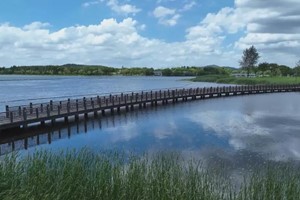At China's Taihu Lake, the third-largest freshwater lake in the country and a vital water source for 17 million residents, scientists at a state key laboratory are leveraging advanced technologies to improve water quality and support ecological restoration efforts. Located in the lower reaches of the Yangtze River, this lake is crucial for one of China's most densely populated and economically developed regions.
A significant part of these efforts is an early warning system developed by researchers at the Taihu Lake Ecosystem Research Station, under the state key Laboratory of Lake Science and Environment. Launched in May 2019, this system combines satellite remote sensing, buoy-based monitoring, and on-site patrols to predict the likelihood of an algae outbreak several days in advance. Since its implementation, it has successfully forecasted over 20 algae outbreaks, greatly enhancing the region's ability to prevent and control such incidents.
The importance of this system cannot be understated, as Taihu Lake suffered a severe algae outbreak in 2007, prompting the provincial government to initiate a comprehensive pollution treatment program. While the algae bloom itself is not poisonous, it poses a significant threat by decimating fish populations and polluting the water.
Li Na, one of the researchers at the laboratory, provided insight into the technology behind the early warning system. "This small round object, pointing vertically downward, is our high spectrum receiving system. It detects the spectrum of sunlight reflected off the water surface, which interacts with optically active substances in the water. Using this data, we can calculate and derive crucial water quality parameters."
In addition to monitoring, the laboratory has been involved in ecological restoration projects within the Taihu Lake system. Lihu Lake, an inland extension of Taihu, has seen significant improvements since 2017. Collaborative efforts between various research institutions have led to the restoration of aquatic vegetation and the reconstruction of the ecosystem in the lake's northwest corner. An impressive 400,000 square meters of "underwater forest" has been reestablished, resulting in clear waters with a depth of around two meters, teeming with aquatic life.
These restoration efforts serve as a model for protecting and managing aquatic ecosystems in other key river basins across China. The success of the Taihu Lake projects offers valuable lessons and insights for future environmental restoration initiatives nationwide.
At the laboratory's smart lake simulation system, researchers are also studying the impact of future global climate change on lakes. The facility includes 72 white tanks, each simulating a small lake with varying temperatures, humidity levels, and wind disturbances. According to Deng Jianming, an associate researcher, these tanks are crucial for understanding how different conditions affect lake ecosystems. "This tank is not heated, and no nutrients are added, so the water stays clear, and the plants thrive. In another tank, spirogyra grows prolifically. We place a biofilm on the substrate to accumulate pollutants, which we then scrub off and analyze in the lab."
The results of these studies are instrumental in guiding the ongoing and future efforts to restore and protect aquatic environments, not just in Taihu Lake but across China.














